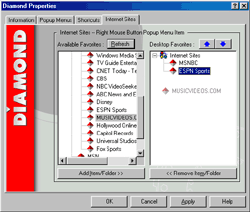| Ok, so what if you don't really care about that feature? InControl Tools 99 also allows you to enable/disable features like V-sync, Single Pass Multi-texturing, the fog table, anti-aliasing, and MIP mapping. All of those features can be independently set using your profiles for each game. If you happen to be playing a game that runs extremely fast on your system you have the option of enabling V-sync in that game alone, so that when you drop down to play some Quake 3 Arena v-sync will be disabled again. The possibilities are endless, and while it's the card that counts, it is the attention to detail that gives the Diamond Viper V770 Ultra the edge over similarly clocked and priced cards from the competition. |
Speaking of clock speeds, how far could AnandTech push the Viper V770 Ultra? Using Diamond's "Boost Levels" the highest setting we could achieve was the Boost Level 5, which is the maximum the drivers allow for. What speeds do the Boost Levels correspond to? Here's a quick table describing exactly that:
| Core Frequency (in MHz) |
Memory Frequency (in MHz) |
|
| Base Level | 150 | 183 |
| Boost Level 1 | 155 | 183 |
| Boost Level 2 | 160 | 183 |
| Boost Level 3 | 165 | 183 |
| Boost Level 4 | 170 | 183 |
| Boost Level 5 | 175 | 183 |
If you'll notice, it doesn’t seem like Diamond wants us overclocking the memory frequency, most likely because the 5.5ns EliteMT SDRAM was only intended to run at 183MHz. Well, AnandTech intended to run that 183MHz SDRAM at 200MHz, so we did. If Hercules can accomplish it with 5.5ns SDRAM, Diamond should be able to as well. To AnandTech's surprise, the V770 Ultra worked fine at the 200MHz memory frequency. The core seemed to be the most difficult part of the card to overclock, after 175MHz there was a significant drop off in stability, and passing the 180MHz mark was a task Diamond's heatsink/fan simply couldn't help accomplish. Keep in mind that the extent of the V770 Ultra's overclocking ability will be unique to each individual card, but it would seem that 175/200 isn't a far stretch for most V770 Ultra owners. Why?
While testing the Hercules Dynamite TNT2 Ultra, one interesting thing that surfaced was the fact that the Leadtek Winfast 3D S320 II managed to outperform the card, albeit by a tiny margin, when both cards were clocked at the same frequency. Upon closer inspection, it was revealed that the Dynamite TNT2 Ultra used considerably slower memory timings to achieve its stability at 200MHz when compared to the Leadtek board which was only required to run at 150MHz (memclock). To no surprise, the Diamond Viper V770 Ultra used the exact same default memory timings as the Dynamite TNT2 Ultra, making the 200MHz memory frequency not a far stretch. With Diamond, it seems as if the core will be the limiting factor, so cross your fingers and hope you pick the right V770 Ultra off the shelf.
| This allows the Diamond V770 Ultra to perform equivalently to the Hercules Dynamite TNT2 Ultra as long as the core/memory speeds remained the same, however the Dynamite TNT2 Ultra gained the advantage in its ability to run at the 195/220 frequency, where the V770 Ultra was limited to only 175MHz core. The 2D quality of the V770 was towards the upper end of the TNT2 Ultra image quality curve, much like the V550 which offered a significant improvement in 2D image quality when compared to other TNT boards. The difference between the V770 and other TNT2 boards in terms of 2D quality is small, but can be noticeable depending on how sensitive your eyes are to picking up poor quality 2D output at higher resolutions (1600 x 1200+). As with most TNT2 boards, the V770 Ultra is AGP 4X compliant, meaning the board will automatically take advantage of the AGP 4X specification (and its transfer rates) when placed in an AGP 4X compliant motherboard. Consider it a free performance boost for upgrading your motherboard in a few months, not bad eh? |











2 Comments
View All Comments
brendamiller - Thursday, January 23, 2020 - link
The Viper V770 Ultra was first of its kind that was introduced several years ago and it set a new trend in their field. I trust only on https://essayyoda.com/review-of-edubirdie-com/ source to read reviews of different online writing service providers. I have also used these NVIDIA's manufactured cards because they were providing great quality.ozzuneoj86 - Tuesday, January 12, 2021 - link
Posting here at a review of Nvidia's first "Ultra" card, in January of 2021, wondering if rumors of nvidia releasing a GTX 3060 Ultra are true. Hard to even fathom the performance difference between what was considered "Ultra" in 1999 and what is considered "Ultra" in 2021.Nearly 1000x the Texel fillrate, 200x the memory bandwidth... and we won't even talk about trying to measure FLOPs on a graphics card in 1999.
And this rumored "Ultra" is a mid range model.
Astonishing.